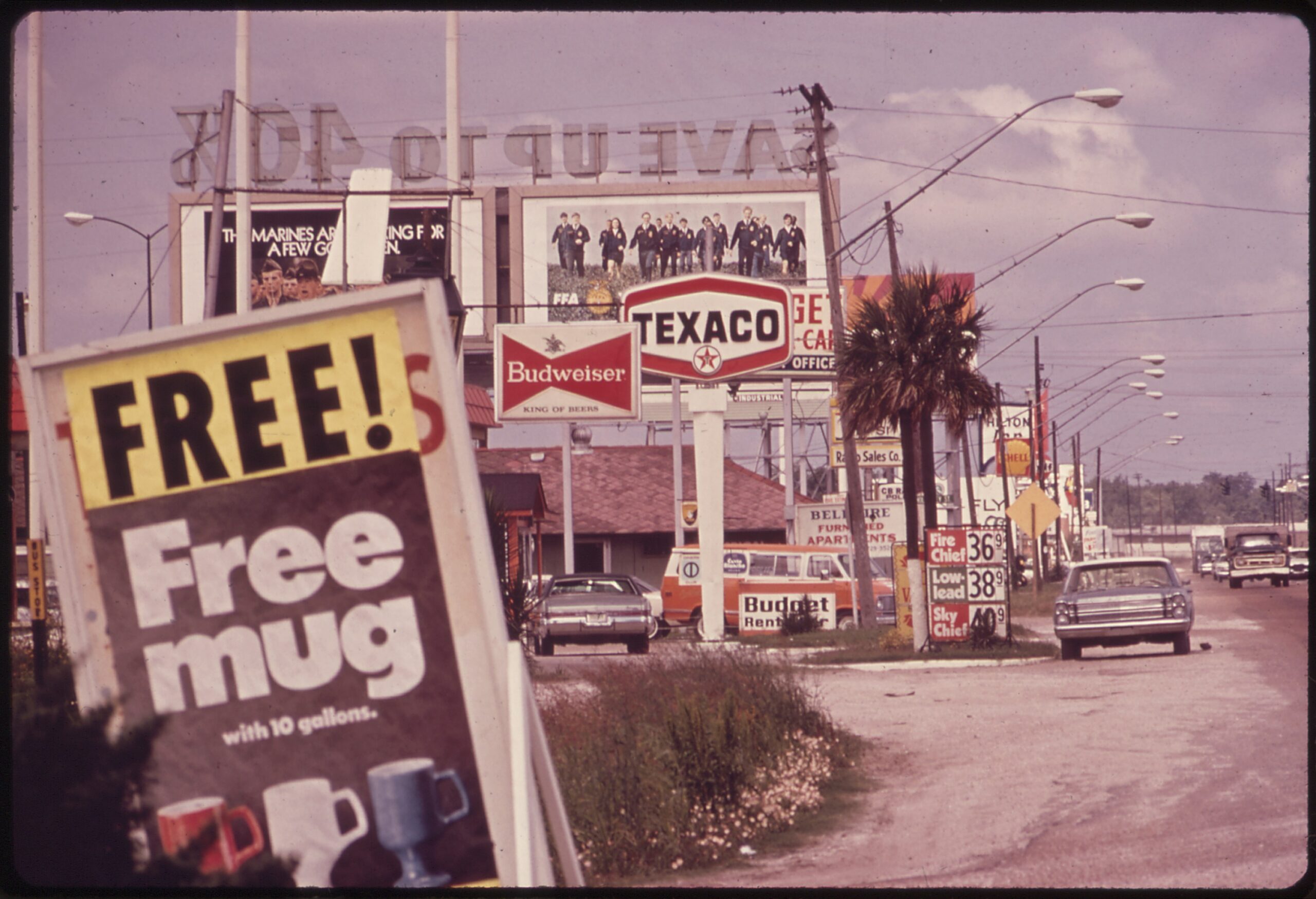
We are pleased to publish the following article by Edward T. McMahon, former president of Scenic America and renowned placemaking and urban planning expert. The article was originally published by Planning Commissioners Journal in 1998, then updated and republished in 2011. It is a cornerstone piece of literature outlining the causes and effects of visual blight as brought on by billboard proliferation.
Come see America the beautiful, if you can. Amber waves of grain? It is more like a ride through the yellow pages: a windshield vista of 50-foot beer cans and towering casino signs.
Many thought billboards were an endangered species in 1965 when Congress passed the Highway Beautification Act. But the law was so riddled with loopholes and enforcement so lax that in recent years, billboard companies have put up thousands of new, bigger, more obtrusive billboards.
In a relatively short time, outdoor advertising has gone from Burma Shave to Blade Runner: from small and folksy to huge and intrusive. We’ve now entered the era of digital billboards giant outdoor TV screens wasting energy while degrading the landscape and distracting drivers.
Billboards are the definition of a roadside distraction. Their entire purpose is to take your eyes off the road and put them on giant outdoor advertisements. Safety is just one of the reasons why many communities have been trying to regulate billboards for decades.
Curbing billboards is not easy, but it can be done. This article lays out the case for billboard control. It discusses the reasons beyond safety for why we need to halt construction of new billboards and strictly regulate those that remain.
1. Billboards are a form of pollution visual pollution
Over the years, billboards have been described as the “junk mail of the highway,” “litter on a stick,” “visual kudzu,” “urban blight,” and more, but in their simplest form billboards are a form of visual pollution.
Regulating billboards is no different from regulating noxious fumes, sewage discharges, or excessive noise. The U.S. Supreme Court has said: “Pollution is not limited to the air we breathe and the water we drink; it can equally offend the eye and ear.”
While the messages on a billboard can be ugly or ordinary, when they are enlarged to the size of a house, placed on poles 50 to 100 feet high, randomly strewn along every street, even covering entire buildings, they become a visual and environmental hazard. Like overly loud noise – strictly regulated in many communities – billboards thrust a discordant commercial note into our environment. They deprive us of visual access to scenic vistas and create a strident, hectic atmosphere in cities.
2. Billboards are out of place in most locations
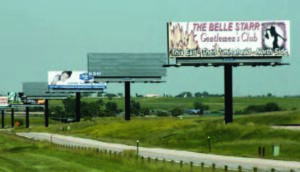
Our landscape is one of America’s greatest resources. Its value is economic as well as aesthetic, psychological as well as recreational, spiritual as well as physical. Every landscape, rural or urban, has its own kind of beauty and uniqueness. In every kind of landscape billboards are a disturbing alien intrusion. Like empty beer cans in a mountain stream, they simply don’t belong because they commercialize, homogenize, and degrade our natural landscape.
Visual clutter may be appropriate in a few limited locations, such as a city’s entertainment district (e.g., Times Square or the Las Vegas Strip). In most cases, however, billboards obliterate architectural character and ruin natural beauty. They also undermine community livability and sustainability. Doug Kelbaugh of the University of Michigan School of Architecture put it this way: “If a building, a landscape, or a city is not beautiful, it will not be loved; if it is not loved, it will not be maintained. In short it won’t be sustained.”
3. Billboards destroy distinctiveness
Billboards look the same whether they are in Mississippi, Montana, or Malaysia. As a result, billboards homogenize our communities. They help turn unique places into “Anyplace.” In fact, almost nothing will destroy the distinctive character of a place faster than uncontrolled signs and billboards. This has negative economic consequences.
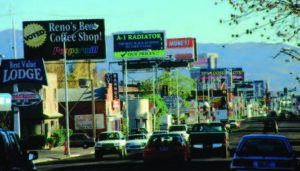
“Community differentiation” is a key concept in economic development today. If you can’t differentiate your community from any other community you have no competitive advantage. Put another way, the image of a community is fundamentally important to its economic well being.
Every day, people make decisions about where to live, invest, or vacation based on what communities look like. Attractive, well-ordered communities havean advantage over ugly, chaotic ones. Take tourism: the more one community comes to look like every other community, the less reason there is to visit. On the other hand, the more a community does to protect and enhance its distinctive character, whether natural or architectural, the more reason there is to visit.
Billboards destroy distinctiveness and undermine our sense of place while they commercialize our neighborhoods. continued on next page
4. Billboards are the only form of advertising that you can’t turn off or avoid
There is a vast difference between seeing an ad – even the same ad – in a magazine, newspaper, on television, or on the internet. When you buy a magazine or turn on the television, you exercise freedom of choice. You can easily close the magazine or turn off the television. You can flip the page or turn the channel.

In contrast, you have no power to turn off or throw away a billboard. Twenty-four hours a day, 365 days a year, billboards force advertising on individuals and communities whether they want it or not. Billboards are placed so you can’t avoid seeing them. Try closing your eyes while driving down a road lined with billboards and you’ll wreck your car.
This is how the billboard industry sells space. They tell advertisers billboards give them more “control” over consumers. They claim the ability to “grab your attention” and rub your nose in advertising.
5. Billboard companies sell something they don’t own – our field of vision
Courts have long held that billboards do not derive their value from the private land they stand on, but from the public roads they stand next to. Courts call this the “parasite principle” – because billboards feed like a parasite off roads they pay almost nothing to build, use, or maintain.
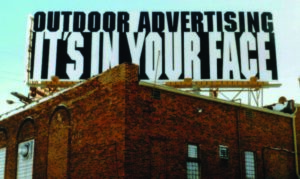
To understand this, imagine that every billboard in America was turned around so that the message could not be seen from the road. The billboards would suddenly be worthless. Their only value comes from their ability to be seen from public roads. Billboard companies charge advertisers based on the circulation of the road. The higher the traffic count, the higher the ad revenue.
Next time you drive on a toll road lined with billboards, consider how you’re being charged to use the road, while the ad company, typically is not. As former California Governor Pat Brown once said: “When a man throws an empty cigarette package from a car, he is liable to a fine, but when a man throws a billboard across a view, he is richly rewarded.”
6. Billboards are ineffective and unnecessary
Billboard companies argue that “people need billboards.” This is completely untrue. There are alternatives to billboards that provide the same information at less cost without degrading our landscape. We have all seen the highway “logo signs” which advertise roadside services such as gas stations, restaurants, hotels, and tourist attractions.

Information on roadside services is also readily available on smart phones, Blackberries, and vehicle information systems. These are far more useful and effective than roadside billboards, particularly when you consider the fact that the vast majority of billboards advertise products or services that have nothing to do with motorist information: beer, cell phones, strip clubs, you name it.
Billboards are also one of the least effective forms of advertising. Billboards represent less than two percent of total advertising in the United States. At best, they are a secondary form of advertising that is used to reinforce ads in other media. The truth is, billboards are so ubiquitous that most people simply tune them out.
Media expert Marshall McLuhan was famous for saying “the medium is the message.” This means that the medium affects us more than the message. Billboards are a downscale medium that blights the countryside, annoys many people, and causes advertising overload.
7. Billboard companies exercise almost no restraint in the placement of outdoor ads
In recent years, billboards have metastasized in every kind of landscape and setting. Billboards now cover up buildings, hover over our neighborhoods, and stare down on homes, schools, churches, parks, and playgrounds. They deface cemeteries and historic districts.
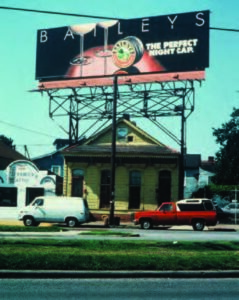
Good for property values?
In the countryside there are few areas sufficiently rural or scenic to be safe from billboards – they are even found in World Heritage Areas and along many designated scenic highways. Rami Tambello, founder of an anti-billboard group in Canada, says: “The outdoor advertising industry has a global culture of non-compliance with the law. Ad companies are erecting illegal billboards all over the world, wherever they can get away with it.”
Today four U.S. states – Alaska, Hawaii, Maine, and Vermont – along with thousands of cities and counties totally prohibit billboards. Many other strictly limit billboards.
Billboard regulation has also gone international: many European countries, like England, have long prohibited billboards in the countryside. Now billboards are becoming an issue in developing countries. In 2000, Athens, Greece was so thick with billboards that it was difficult to see the city’s famous architecture. In preparation for the 2004 Olympics, the city dismantled rooftop billboards to beautify the city and improve its vitality.
In 2007, Säo Paulo Brazil, the world’s ninth largest city, banned billboards and took them all down. Brazilian media called this “a rare victory of the public interest over the private interest, of order over disorder, of aesthetics over ugliness, of cleanliness over trash.”9One of the most important reasons for billboard regulation is because no place in the world will stay scenic and un-commercialized by accident.
8. Billboards are both a cause and a symptom of urban blight
Billboards are a cause of urban blight because they degrade the urban environment, lower property values, and foster contempt for the public realm. They are a symptom of urban blight because one form of blight breeds another. Graffiti, trash, junk cars, billboards – where you find one you’ll usually find the other.
What’s more, billboards are disproportionately located in low income neighborhoods. There are no billboards in Beverly Hills, Georgetown, Palm Beach, Scarsdale, or hundreds of other affluent communities. But drive into low-income neighborhoods in Chicago, Los Angeles, Miami, or any other big city and you will see neighborhoods saturated with billboards. As more of the world’s population moves into cities, there is a growing need for places of respite from the chaos and clutter of urban life.
9. Billboards are bad for business
Beauty and place making are good for business; ugliness is not. Compare two communities: one with billboards and one without. For example, Montgomery County, Maryland, has no billboards. The nearby city of Baltimore, Maryland has thousands of billboards.
Has Montgomery County been negatively affected? On the contrary, Montgomery County has much lower unemployment, and much higher property values, than Baltimore. In fact, the county with America’s lowest unemployment rate – Arlington County, Virginia, has no billboards at all. Lack of billboards does not seem tohave deterred economic vitality here or in other communities. Places like Boulder, Colorado; Chapel Hill, North Carolina; Santa Fe, New Mexico; and Marin County, California, have banned billboards and gained national reputations as great places to live and work.
There is ample evidence to support the assertion that billboard regulation helps business. Thisis why almost all of America’s premier vacation destinations tightly control signs. For example, Vermont runs ads touting its lack of billboards. The former head of the Vermont Chamber of Commerce said: “One of our greatest resources is our scenic beauty. Although there was some initial sensitivity that removing billboards might hurt tourism, it has had the opposite effect. Tourism went up for all businesses, large and small.”
10. Digital billboards use huge amounts of energy, contributing to greenhouse gas emissions and global warming
Digital billboards are energy hogs. They use an enormous amount of electricity, especially compared to conventional billboards. Research by the Central Texas chapter of the U.S. Green Building Council found the energy consumption of one digital billboard 49 times that of a conventional billboard.12Even the spokesman for a major outdoor advertising firm recently acknowledged that a digital billboard consumes roughly 4,600 kilowatts of electricity per month, compared to 920 kilowatts for the average single-family house.
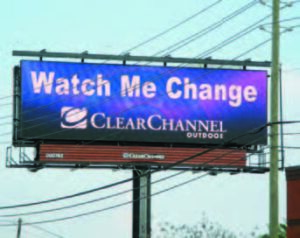
Digital billboards make a mockery of government efforts to “go green.” Sustainable communities simply don’t allow themselves to be overrun with billboards. At its most basic, “sustainable” means enduring; a sustainable community is a place of enduring value. A community littered with ugly, energy guzzling digital signs is the antithesis of a sustainable community.
Billboard Control: What Works
Billboard control is difficult, but not impossible – and thousands of communities around the world have successfully addressed the billboard problem. The legal tools for effective billboard control do exist; the larger question is how can they be used to best advantage.
In my experience, the simplest thing to do right now is to say, “No more billboards,” in other words, to stop the construction of new billboards.
The big mistake many communities make is allowing new billboards in some locations while the industry refuses to take down non-conforming billboards in other locations. This adds insult to injury. With billboards, if things can get worse, they will get worse.
Halting new construction means the number of existing billboards will slowly diminish. It also gives government some leverage in dealing with the industry, especially when you understand that digital signs can generate five times more revenue than conventional signs.
Summing Up
Almost 70 years ago, Fortune magazine, observed, “no place on earth is geographically beyond the reach of the hawkers and hucksters.” Today commercialism – particularly in the form of outdoor advertising pervades our world to an extent unimaginable, even several decades ago. It seems now that the hucksters won’t be satisfied until every square inch of public space is filled with giant structures festooned with the message “BUY.”
Billboards degrade our landscape and our culture. The old fashioned ideals of community, beauty, modesty, and respect for nature stand for nothing in the face of rampant commercialism. Now is the time to stand up and just say no to out of control billboards.
 Scenic America’s first president Ed McMahon developed an interest in land use planning and landscape conservation as a result of serving a tour of duty in Germany as a young soldier in the US Army. A native of Birmingham, Alabama, Ed spent two years traveling throughout Europe from his post at US Army headquarters in the postcard-perfect town of Heidelberg, Germany. Over the course of Ed’s tenure, Scenic America worked closely with local and state governments to pass sign ordinances, tree protection legislation, and other measures to protect community character and identity. We are proud to honor Ed’s legacy by publishing his catalog of industry-renowned work on the Scenic America website in perpetuity. Read more about Ed McMahon
Scenic America’s first president Ed McMahon developed an interest in land use planning and landscape conservation as a result of serving a tour of duty in Germany as a young soldier in the US Army. A native of Birmingham, Alabama, Ed spent two years traveling throughout Europe from his post at US Army headquarters in the postcard-perfect town of Heidelberg, Germany. Over the course of Ed’s tenure, Scenic America worked closely with local and state governments to pass sign ordinances, tree protection legislation, and other measures to protect community character and identity. We are proud to honor Ed’s legacy by publishing his catalog of industry-renowned work on the Scenic America website in perpetuity. Read more about Ed McMahon